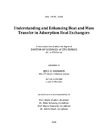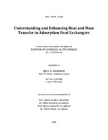Understanding and Enhancing Heat and Mass Transfer in Adsorption Heat Exchangers
dc.contributor.author
Ammann, Jens
dc.contributor.supervisor
Studart, André R.
dc.contributor.supervisor
Schossig, Peter
dc.contributor.supervisor
Mazzotti, Marco
dc.contributor.supervisor
Ruch, Patrick
dc.date.accessioned
2020-03-30T11:35:28Z
dc.date.available
2019-03-28T10:01:17Z
dc.date.available
2019-03-29T08:09:36Z
dc.date.available
2019-03-29T10:59:39Z
dc.date.available
2020-03-30T11:35:28Z
dc.date.issued
2018
dc.identifier.uri
http://hdl.handle.net/20.500.11850/334359
dc.identifier.doi
10.3929/ethz-b-000334359
dc.description.abstract
With the goals of energy saving and environmental stewardship, adsorption heat pumps have become an increasingly viable option to reduce the use of fossil fuels and electricity for heating and cooling by using waste heat from industry, power stations or photovoltaic/thermal systems for energy-efficient heating and cooling. Due to the low power density and the resulting high mass, size and thereby capital costs, the technology still requires improvements in materials, designs and performance to achieve widespread adoption. The adsorption heat exchanger (AdHEX) is the technology’s component with the highest potential for power density improvements, since it represents the most bulky part and has not yet reached the level of maturity of other heat pump technologies such as mechanical compression and absorption. Despite recent improvements, the power density in current systems is limited by transport resistances in the AdHEX. Therefore, various transport rate enhancement approaches have been proposed in the literature. However, most approaches so far have not focused on identifying and facilitating the limiting transport mechanism. Improving sorption rates requires the determination of the limiting transport phenomenon, which is usually difficult as mass and heat transport are strongly coupled by the sorption process.
This thesis focuses on the characterization and optimization of mass and heat transport in solid sorption heat pump technology. A novel experimental approach to discriminate between mass and heat transport in temperature-swing sorption processes is described. In this isochoric method, temperature swings are applied to an adsorbent while mass transport is captured by the loading transient and heat transport is quantified by the transient of the adsorbent temperature measured by an IR-camera. The sorption equilibrium properties are measured prior to the kinetic measurement in the same setup. With both equilibrium and kinetic data, the respective equivalent driving temperatures for mass and heat transport are discriminated. Based on these driving temperatures, the time-averaged mass and heat transport impedances are determined. The novel characterization method introduced here is termed Transport Impedance Analysis (TIA) and enables to identify transport limitations by quantitatively comparing heat and mass transport in-situ. In order to evaluate the performance of new structures, Ragone plots were introduced to compare the pareto-front, emerging from the trade-off between energy and power density of different adsorbent architectures.TIA was applied to commercial adsorbent architectures to determine the transport limitation in these systems. Different arrangements of silica beads and coatings consisting of zeolite microparticles and organic binder were examined using water as working fluid. While a monolayer silica bed configuration exhibits balanced heat and mass transport, we found that a bilayer and a thermally-enhanced configuration are limited by heat and mass transport, respectively. Mass transport was found to be the main limiting factor in zeolite coatings despite the fact that most approaches reported in literature predominantly focus on improving heat transport.
Based on these findings, this work focused next on facilitating the limiting mass transport by introducing directed porosity into the adsorbent coatings. To this end, model hierarchical adsorbents were fabricated by sawing uniformly spaced vertical two-dimensional channels of width 75 μm into zeolite coatings. With the help of TIA, a characteristic transport length (CTL) model was introduced that predicts the optimal ratio of heat to mass transport diffusion lengths in these hierarchical adsorbents. The coatings with optimal pore architecture exhibit a higher power density than thinner non-structured coatings with the same amount of adsorbent mass per unit of heat exchanger area.
Since these model structures cannot be easily fabricated at an industrial scale, an inexpensive route for the manufacturing of structured zeolite coatings based on the bottom-up assembly of colloids directed by magnetic and capillary forces was developed. Such an assembly process relies on the chaining of oil droplets under an external magnetic field followed by the formation of a percolating network of bridged adsorbent particles upon drying. This results in vertical one-dimensional open channels and thermal bridges that co-enhance mass and heat transport across the zeolite coating. Since these one-dimensional channels can be placed close to each other while maintaining a low channel volume fraction, the one-dimensional channels produced by colloidal assembly exhibit a lower mass transport impedance compared to the two-dimensional channels.
Overall, this thesis provides a powerful toolset to characterize and optimize mass and heat transport in temperature-swing processes using a simple isochoric sorption test-rig. With this toolset, the transport rates in zeolite coatings were considerably improved, enabling a 3-fold increase in power density compared to non-structured coatings using an up-scalable manufacturing process. These improvements might be adaptable to other processes that require high mass and heat transport such as gas separation processes or to applications that requires high electrical conductivity and mass transport such as solid oxide fuel cells or batteries.
en_US
dc.format
application/pdf
en_US
dc.language.iso
en
en_US
dc.publisher
ETH Zurich
en_US
dc.rights.uri
http://rightsstatements.org/page/InC-NC/1.0/
dc.subject
Adsorption heat exchanger (AdHex)
en_US
dc.subject
heat and mass transfer
en_US
dc.subject
Adsorbent coating
en_US
dc.subject
Silica
en_US
dc.subject
Adsorption kinetics
en_US
dc.subject
Water adsorption
en_US
dc.subject
SAPO-34
en_US
dc.subject
Zeolite
en_US
dc.subject
Self Assembly
en_US
dc.subject
Magnetic alignment
en_US
dc.subject
Emulsion templating
en_US
dc.title
Understanding and Enhancing Heat and Mass Transfer in Adsorption Heat Exchangers
en_US
dc.type
Doctoral Thesis
dc.rights.license
In Copyright - Non-Commercial Use Permitted
dc.date.published
2019-03-29
ethz.size
136 p.
en_US
ethz.code.ddc
DDC - DDC::6 - Technology, medicine and applied sciences::660 - Chemical engineering
en_US
ethz.identifier.diss
25558
en_US
ethz.publication.place
Zurich
en_US
ethz.publication.status
published
en_US
ethz.leitzahl
ETH Zürich::00002 - ETH Zürich::00012 - Lehre und Forschung::00007 - Departemente::02160 - Dep. Materialwissenschaft / Dep. of Materials::03831 - Studart, André R. / Studart, André R.
en_US
ethz.date.deposited
2019-03-28T10:01:31Z
ethz.source
FORM
ethz.eth
yes
en_US
ethz.availability
Open access
en_US
ethz.date.embargoend
2020-03-29
ethz.rosetta.installDate
2019-03-29T10:59:54Z
ethz.rosetta.lastUpdated
2020-03-30T11:35:39Z
ethz.rosetta.versionExported
true
ethz.COinS
ctx_ver=Z39.88-2004&rft_val_fmt=info:ofi/fmt:kev:mtx:journal&rft.atitle=Understanding%20and%20Enhancing%20Heat%20and%20Mass%20Transfer%20in%20Adsorption%20Heat%20Exchangers&rft.date=2018&rft.au=Ammann,%20Jens&rft.genre=unknown&rft.btitle=Understanding%20and%20Enhancing%20Heat%20and%20Mass%20Transfer%20in%20Adsorption%20Heat%20Exchangers
Files in this item
Publication type
-
Doctoral Thesis [29812]


